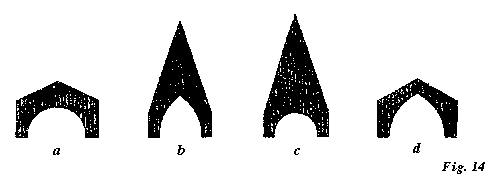VI. THE NATURE OF GOTHIC 255
In the figure, f is, perhaps, the average of Romanesque slope, and g of Gothic.
§ 92. But although we do not find a transition from one school into the other in the slope of the gable, there is often a confusion between the two schools in the association of the gable with the arch below it. It has just been stated that the pure Romanesque condition is the round arch under the low gable, a, Fig. 14, below, and the pure Gothic condition is the pointed arch under the high gable, b. But in the passage from one style to the other, we sometimes find the two conditions reversed: the pointed arch under a low gable, as d, or the round arch under a high gable, as c.
 |
The form d occurs in the tombs of Verona, and c in the doors of Venice.
§ 93. We have thus determined the relation of Gothic to the other architectures of the world, as far as regards the main lines of its construction; but there is still one word which needs to be added to our definition of its form, with respect to a part of its decoration, which rises out of that construction. We have seen that the first condition of its form is, that it shall have pointed arches. When Gothic is perfect, therefore, it will follow that the pointed arches must be built in the strongest possible manner.
Now, if the reader will look back to Chapter XI. of Vol. I., he will find the subject of the masonry of the pointed arch discussed at length, and the conclusion deduced, that of all possible forms of the pointed arch (a certain weight of material being given), that generically represented at e,
[Version 0.04: March 2008]